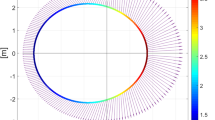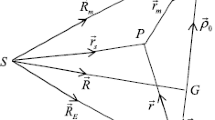Abstract
In non-resonant cases, a constant part coming from the perturbations can be easily separated from the observed mean mean motion, which can be called the perturbed part. An another part created by resonance must be separated from the observed mean motion in the case of the first three Galilean satellites. The determination of it gives better value of the semi-major axis.
In this investigation, the analytical process is chosen to avoid a mixture of orders in successive expansions and integrations.
The main terms entering in the computation of the libration are the great inequalities of the first three satellites. Each of them is introduced in the development by its eight components; while in Sampson's theory, only the great inequality of Satellite 2 is given by two components.
The equations of motion used in this work are derived from Sagnier's theory.
Similar content being viewed by others
Bibliographic
Sagnier, J. L.: 1973,Astron. Astrophys. 25, 113–124.
Sagnier, J. L.: 1975,Celest. Mech. 12, 19–25.
Sampson. R. A.: 1921,Mem. Roy. Astron. Soc. 63.
Author information
Authors and Affiliations
Additional information
Proceedings of the Conference on ‘Analytical Methods and Ephemerides: Theory and Observations of the Moon and Planets’. Facultés universitaires Notre Dame de la Paix, Namur, Belgium, 28–31 July, 1980.
Rights and permissions
About this article
Cite this article
Vu, D.T. Determination des demi-grands axes des satellites galileens de Jupiter. Celestial Mechanics 26, 265–270 (1982). https://doi.org/10.1007/BF01230721
Issue Date:
DOI: https://doi.org/10.1007/BF01230721




